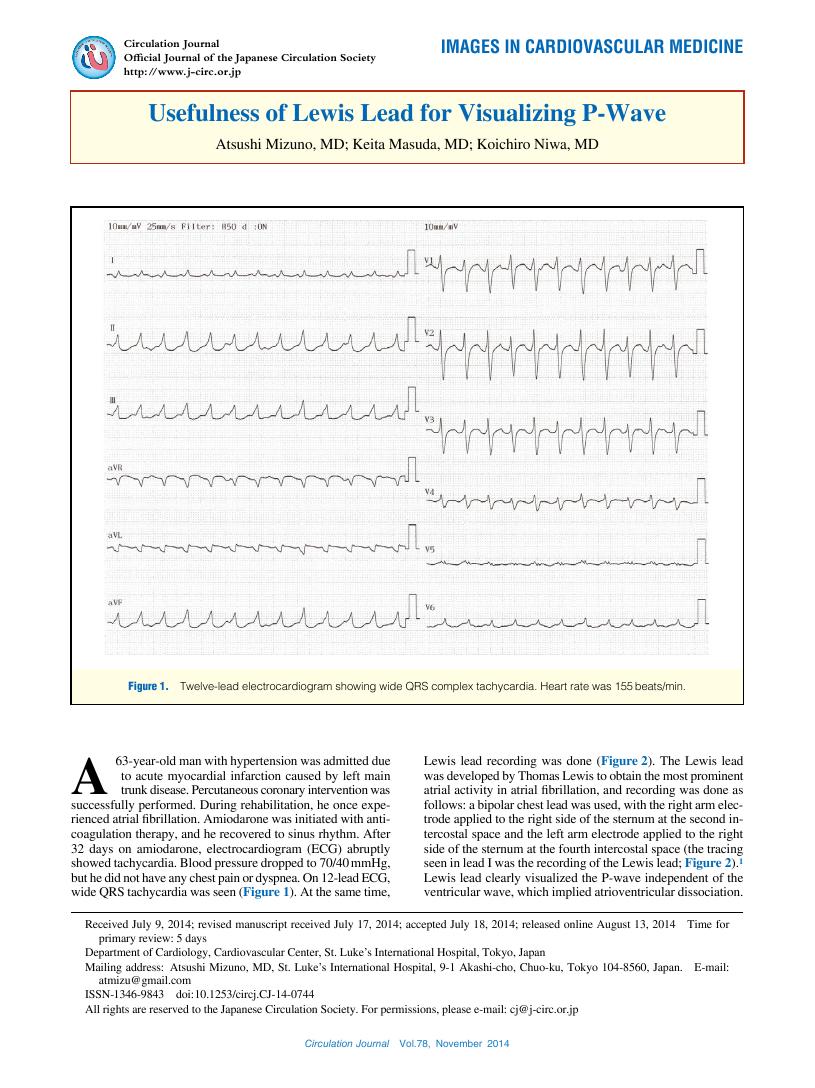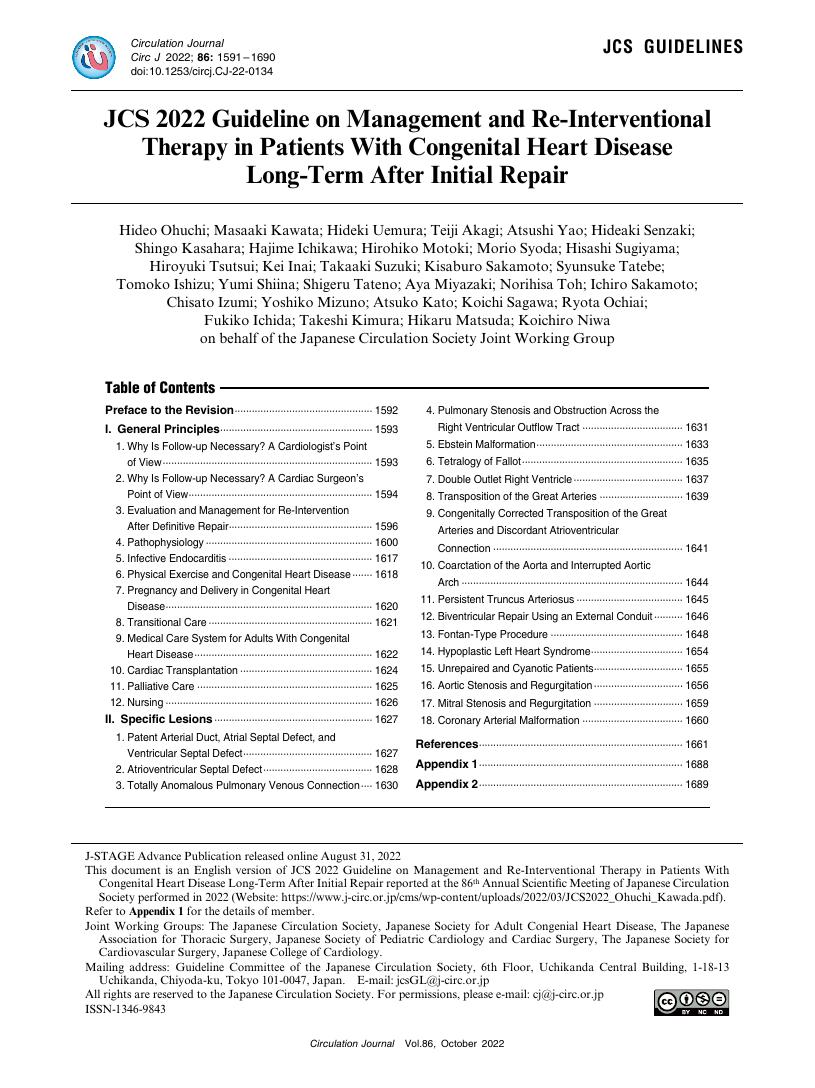- 著者
- Hideo Ohuchi Masaaki Kawata Hideki Uemura Teiji Akagi Atsushi Yao Hideaki Senzaki Shingo Kasahara Hajime Ichikawa Hirohiko Motoki Morio Syoda Hisashi Sugiyama Hiroyuki Tsutsui Kei Inai Takaaki Suzuki Kisaburo Sakamoto Syunsuke Tatebe Tomoko Ishizu Yumi Shiina Shigeru Tateno Aya Miyazaki Norihisa Toh Ichiro Sakamoto Chisato Izumi Yoshiko Mizuno Atsuko Kato Koichi Sagawa Ryota Ochiai Fukiko Ichida Takeshi Kimura Hikaru Matsuda Koichiro Niwa on behalf of the Japanese Circulation Society Joint Working Group
- 出版者
- The Japanese Circulation Society
- 雑誌
- Circulation Journal (ISSN:13469843)
- 巻号頁・発行日
- pp.CJ-22-0134, (Released:2022-08-31)
- 参考文献数
- 1071
- 被引用文献数
- 6
- 著者
- Atsushi Mizuno Keita Masuda Koichiro Niwa
- 出版者
- The Japanese Circulation Society
- 雑誌
- Circulation Journal (ISSN:13469843)
- 巻号頁・発行日
- pp.CJ-14-0744, (Released:2014-08-13)
- 参考文献数
- 10
- 被引用文献数
- 1 5
- 著者
- Tomoaki Murakami Yoko Horibata Shigeru Tateno Yasutaka Kawasoe Koichiro Niwa
- 出版者
- 一般社団法人 日本血管不全学会
- 雑誌
- Vascular Failure (ISSN:24324477)
- 巻号頁・発行日
- vol.4, no.2, pp.39-45, 2021-08-31 (Released:2021-09-08)
- 参考文献数
- 20
- 被引用文献数
- 1
Background:We previously reported enhanced pressure wave reflection in adult patients with congenital heart disease, which can result in high systolic blood pressure. Although hypertension could cause significant damage to vulnerable systemic ventricles, few studies have reported on blood pressure in adults with congenital heart disease thus far. The purpose of this study was to investigate the incidence and risk factors associated with hypertension in adult patients with congenital heart disease. Methods and Results:One-hundred and thirty-one adults with congenital heart disease were enrolled in this study. Brachial blood pressure was measured using an HEM-9000AI system (Omron Healthcare Co., Ltd., Kyoto, Japan). Patients with systolic/diastolic blood pressure ≥140/90 mmHg or those taking medication for hypertension were defined as hypertension. A systolic blood pressure ≥ +2 SD of systolic blood pressure in the age- and sex-matched general population was defined as high systolic blood pressure. The patients were aged 37.0 ± 15.0 years. Hypertension was observed in sixteen patients (16%), and logistic regression analysis revealed that the determinant of hypertension was age (years) (odds ratio [OR], 1.078; 95% confidence interval [CI], 1.029-1.129; p = 0.001). High systolic blood pressure was observed in twenty patients (20%). Logistic regression analysis revealed that the determinants of high systolic blood pressure were age (years) (OR, 1.072; 95%CI, 1.020-1.126; p = 0.016) and body mass index (kg/m2) (OR, 1.261; 95% CI, 1.054-1.508; p = 0.011). The body mass index in young patients (≤ 30 years) with high systolic blood pressure was remarkably high (31.2 ± 3.0 kg/m2). Conclusions:The incidence of high systolic blood pressure is high in adult patients with congenital heart disease. High systolic blood pressure is common in older patients and is associated with a high body mass index in young patients.
- 著者
- Atsushi Mizuno Koichiro Niwa Kozo Matsuo Masaaki Kawada Aya Miyazaki Yoshiki Mori Norifumi Nakanishi Hideo Ohuchi Mamie Watanabe Atsushi Yao Kei Inai
- 出版者
- The Japanese Circulation Society
- 雑誌
- Circulation Journal (ISSN:13469843)
- 巻号頁・発行日
- vol.77, no.12, pp.2942-2947, 2013 (Released:2013-11-25)
- 参考文献数
- 33
- 被引用文献数
- 16 21
Background: Although the survival rate for repaired Tetralogy of Fallot (TOF) is dramatically improving, anatomical and functional residua and sequelae followed by arrhythmias and sudden death are still challenging issues to be resolved. Reoperation can reduce the incidence of arrhythmias and sudden death, but there is no consensus on the indications of reoperation for patients with TOF, especially in Japan. Methods and Results: A cross-sectional questionnaire survey of reoperation indications in patients with TOF was performed through a Japanese multicenter study. The questionnaire, which focused on the number of repaired TOF patients aged >15 years old, reoperation indications and management, was sent to the institutions belonging to Japanese Society for Adult Congenital Heart Disease. In total, 41.5% (78/188) of the institutions replied. The total number of repaired TOF patients was 4,010, and sudden cardiac death was observed in 45.236/4,010 (5.9%) experienced reoperation. Pulmonary stenosis (32%) and pulmonary regurgitation (29%) were the most common reasons for reoperation. There were only 2 implantable cardioverter defibrillator or resynchronization therapy defibrillator implantations. The physiological/anatomical indications of reoperation differed among the hospitals. Conclusions: Approximately 1.1% of patients suffered sudden death and 6% of repaired TOF patients had reoperation. The indications of reoperation, however, varied among the institutions. Therefore, detailed information for each case of sudden death or reoperation should be collected and analyzed in order to establish guidelines for reoperation. (Circ J 2013; 77: 2942–2947)
- 著者
- Atsushi Mizuno Keita Masuda Koichiro Niwa
- 出版者
- The Japanese Circulation Society
- 雑誌
- Circulation Journal (ISSN:13469843)
- 巻号頁・発行日
- vol.78, no.11, pp.2774-2775, 2014-10-24 (Released:2014-10-24)
- 参考文献数
- 10
- 被引用文献数
- 4 5
- 著者
- Shinobu Sugihara Ichiro Hisatome Masanari Kuwabara Koichiro Niwa Nani Maharani Masahiko Kato Kazuhide Ogino Toshihiro Hamada Haruaki Ninomiya Yukihito Higashi Kimiyoshi Ichida Kazuhiro Yamamoto
- 出版者
- The Japanese Circulation Society
- 雑誌
- Circulation Journal (ISSN:13469843)
- 巻号頁・発行日
- vol.79, no.5, pp.1125-1132, 2015-04-24 (Released:2015-04-24)
- 参考文献数
- 41
- 被引用文献数
- 24 82
Background:Uric acid (UA) serves as an antioxidant in vascular endothelial cells. UA transporter 1 (URAT1) encoded by SLC22A12 is expressed in the kidney and vessels and its loss of function causes hypouricemia. The purpose of this study was to examine whether there is any endothelial dysfunction in patients with hypouricemia.Methods and Results:Twenty-six patients with hypouricemia (<2.5 mg/dl) and 13 healthy control subjects were enrolled. Endothelial function was evaluated using flow-mediated dilation (FMD). mRNA of UA transporters expressed in cultured human umbilical endothelial cells (HUVEC) was detected on RT-PCR. There was a positive correlation between FMD and serum UA in the hypouricemia group. URAT1 loss-of-function mutations were found in the genome of 21 of 26 patients with hypouricemia, and not in the other 5. In the hypouricemia groups, serum UA in homozygous and compound heterozygous patients was significantly lower than in other groups, suggesting that severity of URAT1 dysfunction may influence the severity of hypouricemia. Thirteen of 16 hypouricemia subjects with homozygous and compound heterozygote mutations had SUA <0.8 mg/dl and their FMD was lower than in other groups. HUVEC do not express mRNA of URAT1, suggesting the null role of URAT1 in endothelial function.Conclusions:Depletion of UA due to SLC22A12/URAT1 loss-of-function mutations causes endothelial dysfunction in hypouricemia patients. (Circ J 2015; 79: 1125–1132)
- 著者
- Hiroyuki Yamamoto Kyoko Yamamoto Katsumi Yoshida Chiyohiko Shindoh Kyoko Takeda Masami Monden Hiroko Izumo Hiroyuki Niinuma Yutaro Nishi Koichiro Niwa Yasuhiro Komatsu
- 出版者
- Tohoku University Medical Press
- 雑誌
- The Tohoku Journal of Experimental Medicine (ISSN:00408727)
- 巻号頁・発行日
- vol.237, no.3, pp.201-207, 2015 (Released:2015-10-24)
- 参考文献数
- 24
- 被引用文献数
- 2 2
Chronic kidney disease (CKD) is a global public health issue, and strategies for its early detection and intervention are imperative. The latest Japanese CKD guideline recommends that patients without diabetes should be classified using the urine protein-to-creatinine ratio (PCR) instead of the urine albumin-to-creatinine ratio (ACR); however, no validation studies are available. This study aimed to validate the PCR-based CKD risk classification compared with the ACR-based classification and to explore more accurate classification methods. We analyzed two previously reported datasets that included diabetic and/or cardiovascular patients who were classified into early CKD stages. In total, 860 patients (131 diabetic patients and 729 cardiovascular patients, including 193 diabetic patients) were enrolled. We assessed the CKD risk classification of each patient according to the estimated glomerular filtration rate and the ACR-based or PCR-based classification. The use of the cut-off value recommended in the current guideline (PCR 0.15 g/g creatinine) resulted in risk misclassification rates of 26.0% and 16.6% for the two datasets. The misclassification was primarily caused by underestimation. Moderate to substantial agreement between each classification was achieved: Cohen’s kappa, 0.56 (95% confidence interval, 0.45-0.69) and 0.72 (0.67-0.76) in each dataset, respectively. To improve the accuracy, we tested various candidate PCR cut-off values, showing that a PCR cut-off value of 0.08-0.10 g/g creatinine resulted in improvement in the misclassification rates and kappa values. Modification of the PCR cut-off value would improve its efficacy to identify high-risk populations who will benefit from early intervention.
- 著者
- Hideo Ohuchi Masaaki Kawata Hideki Uemura Teiji Akagi Atsushi Yao Hideaki Senzaki Shingo Kasahara Hajime Ichikawa Hirohiko Motoki Morio Syoda Hisashi Sugiyama Hiroyuki Tsutsui Kei Inai Takaaki Suzuki Kisaburo Sakamoto Syunsuke Tatebe Tomoko Ishizu Yumi Shiina Shigeru Tateno Aya Miyazaki Norihisa Toh Ichiro Sakamoto Chisato Izumi Yoshiko Mizuno Atsuko Kato Koichi Sagawa Ryota Ochiai Fukiko Ichida Takeshi Kimura Hikaru Matsuda Koichiro Niwa on behalf of the Japanese Circulation Society Joint Working Group
- 出版者
- The Japanese Circulation Society
- 雑誌
- Circulation Journal (ISSN:13469843)
- 巻号頁・発行日
- vol.86, no.10, pp.1591-1690, 2022-09-22 (Released:2022-09-22)
- 参考文献数
- 1071
- 被引用文献数
- 6
- 著者
- Keiko Yamasaki Hiroyuki Sawatari Nao Konagai Chizuko A. Kamiya Jun Yoshimatsu Jun Muneuchi Mamie Watanabe Terunobu Fukuda Atsushi Mizuno Ichiro Sakamoto Kenichiro Yamamura Tomoko Ohkusa Hiroyuki Tsutsui Koichiro Niwa Akiko Chishaki
- 出版者
- The Japanese Circulation Society
- 雑誌
- Circulation Journal (ISSN:13469843)
- 巻号頁・発行日
- vol.83, no.11, pp.2257-2264, 2019-10-25 (Released:2019-10-25)
- 参考文献数
- 38
- 被引用文献数
- 5
Background:The average maternal age at delivery, and thus the associated maternal risk are increasing including in women with congenital heart disease (CHD). A comprehensive management approach is therefore required for pregnant women with CHD. The present study aimed to investigate the factors determining peripartum safety in women with CHD.Methods and Results:We retrospectively collected multicenter data for 217 pregnant women with CHD (age at delivery: 31.4±5.6 years; NYHA classifications I and II: 88.9% and 7.4%, respectively). CHD severity was classified according to the American College of Cardiology/American Heart Association guidelines as simple (n=116), moderate complexity (n=69), or great complexity (n=32). Cardiovascular (CV) events (heart failure: n=24, arrhythmia: n=9) occurred in 30 women during the peripartum period. Moderate or great complexity CHD was associated with more CV events during gestation than simple CHD. CV events occurred earlier in women with moderate or great complexity compared with simple CHD. Number of deliveries (multiparity), NYHA functional class, and severity of CHD were predictors of CV events.Conclusions:This study identified not only the severity of CHD according to the ACC/AHA and NYHA classifications, but also the number of deliveries, as important predictive factors of CV events in women with CHD. This information should be made available to women with CHD and medical personnel to promote safe deliveries.
- 著者
- Shinobu Sugihara Ichiro Hisatome Masanari Kuwabara Koichiro Niwa Nani Maharani Masahiko Kato Kazuhide Ogino Toshihiro Hamada Haruaki Ninomiya Yukihito Higashi Kimiyoshi Ichida Kazuhiro Yamamoto
- 出版者
- 日本循環器学会
- 雑誌
- Circulation Journal (ISSN:13469843)
- 巻号頁・発行日
- pp.CJ-14-1267, (Released:2015-02-23)
- 参考文献数
- 41
- 被引用文献数
- 10 82
Background:Uric acid (UA) serves as an antioxidant in vascular endothelial cells. UA transporter 1 (URAT1) encoded by SLC22A12 is expressed in the kidney and vessels and its loss of function causes hypouricemia. The purpose of this study was to examine whether there is any endothelial dysfunction in patients with hypouricemia.Methods and Results:Twenty-six patients with hypouricemia (<2.5 mg/dl) and 13 healthy control subjects were enrolled. Endothelial function was evaluated using flow-mediated dilation (FMD). mRNA of UA transporters expressed in cultured human umbilical endothelial cells (HUVEC) was detected on RT-PCR. There was a positive correlation between FMD and serum UA in the hypouricemia group. URAT1 loss-of-function mutations were found in the genome of 21 of 26 patients with hypouricemia, and not in the other 5. In the hypouricemia groups, serum UA in homozygous and compound heterozygous patients was significantly lower than in other groups, suggesting that severity of URAT1 dysfunction may influence the severity of hypouricemia. Thirteen of 16 hypouricemia subjects with homozygous and compound heterozygote mutations had SUA <0.8 mg/dl and their FMD was lower than in other groups. HUVEC do not express mRNA of URAT1, suggesting the null role of URAT1 in endothelial function.Conclusions:Depletion of UA due to SLC22A12/URAT1 loss-of-function mutations causes endothelial dysfunction in hypouricemia patients.


